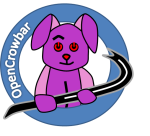 I’m excited to be announcing OpenCrowbar’s first release, Anvil, for the community. Looking back on our original design from June 2012, we’ve accomplished all of our original objectives and more.
I’m excited to be announcing OpenCrowbar’s first release, Anvil, for the community. Looking back on our original design from June 2012, we’ve accomplished all of our original objectives and more.Now that we’ve got the foundation ready, our next release (OpenCrowbar Broom) focuses on workload development on top of the stable Anvil base. This means that we’re ready to start working on OpenStack, Ceph and Hadoop. So far, we’ve limited engagement on workloads to ensure that those developers would not also be trying to keep up with core changes. We follow emergent design so I’m certain we’ll continue to evolve the core; however, we believe the Anvil release represents a solid foundation for workload development.
There is no more comprehensive open bare metal provisioning framework than OpenCrowbar. The project’s focus on a complete operations model that comprehends hardware and network configuration with just enough orchestration delivers on a system vision that sets it apart from any other tool. Yet, Crowbar also plays nicely with others by embracing, not replacing, DevOps tools like Chef and Puppet.
Now that the core is proven, we’re porting the Crowbar v1 RAID and BIOS configuration into OpenCrowbar. By design, we’ve kept hardware support separate from the core because we’ve learned that hardware generation cycles need to be independent from the operations control infrastructure. Decoupling them eliminates release disruptions that we experienced in Crowbar v1 and makes it much easier to use to incorporate hardware from a broad range of vendors.
Here are some key components of Anvil
- UI, CLI and API stable and functional
- Boot and discovery process working PLUS ability to handle pre-populating and configuration
- Chef and Puppet capabilities including Birk Shelf v3 support to pull in community upstream DevOps scripts
- Docker, VMs and Physical Servers
- Crowbar’s famous “late-bound” approach to configuration and, critically, networking setup
- IPv6 native, Ruby 2, Rails 4, preliminary scale tuning
- Remarkably flexible and transparent orchestration (the Annealer)
- Multi-OS Deployment capability, Ubuntu, CentOS, or Different versions of the same OS
Getting the workloads ported is still a tremendous amount of work but the rewards are tremendous. With OpenCrowbar, the community has a new way to collaborate and integration this work. It’s important to understand that while our goal is to start a quarterly release cycle for OpenCrowbar, the workload release cycles (including hardware) are NOT tied to OpenCrowbar. The workloads choose which OpenCrowbar release they target. From Crowbar v1, we’ve learned that Crowbar needed to be independent of the workload releases and so we want OpenCrowbar to focus on maintaining a strong ops platform.
This release marks four years of hard-earned Crowbar v1 deployment experience and two years of v2 design, redesign and implementation. I’ve talked with DevOps teams from all over the world and listened to their pains and needs. We have a long way to go before we’re deploying 1000 node OpenStack and Hadoop clusters, OpenCrowbar Anvil significantly moves the needle in that direction.
Thanks to the Crowbar community (Dell and SUSE especially) for nurturing the project, and congratulations to the OpenCrowbar team getting us this to this amazing place.
Pingback: OpenCrowbar: ready to fly as OpenOps neutral platform – Dell stepping back | Rob Hirschfeld
Pingback: OpenCrowbar Design Principles: Reintroduction [Series 1 of 6] | Rob Hirschfeld
Pingback: OpenCrowbar Design Principles: The Ops Challenge [Series 2 of 6] | Rob Hirschfeld
Pingback: OpenCrowbar Design Principles: Late Binding [Series 3 of 6] | Rob Hirschfeld
Pingback: OpenCrowbar Design Principles: Simulated Annealing [Series 4 of 6] | Rob Hirschfeld
Pingback: OpenCrowbar Design Principles: Emergent services [Series 5 of 6] | Rob Hirschfeld
Pingback: OpenCrowbar Design Principles: Attribute Injection [Series 6 of 6] | Rob Hirschfeld
Pingback: You need a Squid Proxy fabric! Getting Ready State Best Practices | Rob Hirschfeld
Pingback: Need a physical ops baseline? Crowbar continues to uniquely fill gap | Rob Hirschfeld
Pingback: Starting RackN – Delivering open ops by pulling an OpenCrowbar Bunny out of our hat | Rob Hirschfeld